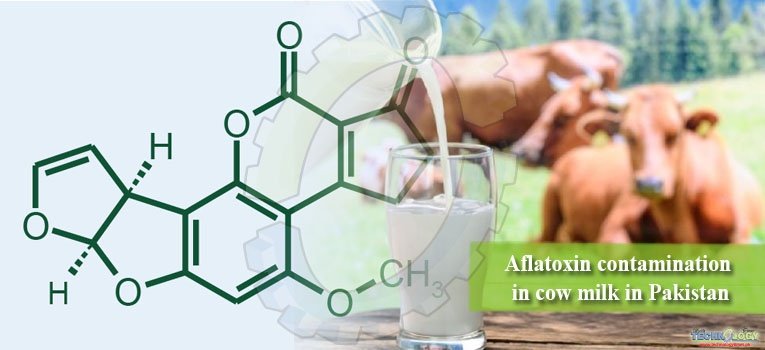The quantity and quality of food available is an essential key in improving the health of people and the maintenance of food, making it free of aflatoxin contamination is also very important in context of health.

Talking about the health and need of Pakistani population which majorly depends on the need and use of milk and dairy products and almost 10% of the total income of one house is spent on milk. This key role of milk focuses the attention towards the quality and purity of small milk producers starting from small urban areas towards the traditional milk marketing chains.
One may think that how the milk from cow can be contaminated, the reason may be one or more. One of the reason is that the feed given to cow to increase the production of milk may often get contaminated with mycotoxins which when ingested by animals are later transferred into milk. Aflatoxins like B1, B2, G1 and G2 are mycotoxins and are major concerns to the industries like dairy.
They all are naturally occurring mycotoxins in soil which are produced by fungi species Aspergillus flavus and Aspergillus parasiticus. Aflatoxins are highly toxic and play role in causing liver cancers, immune system disorders and issued related to growth in children. Intake of aflatoxins may be fatal as it is reported that it causes deaths in both humans and animals upon ingestion of contaminated food and feed ingredients with mycotoxins especially aflatoxins.
The economic status of any nation depends upon the health and nutritional status of nations. With the increasing population of Pakistan it is still facing number of nutritional deficiencies and diseases. Milk and products of milk play important role in fulfilling the nutritional values of the poor population in Pakistan and according to one research one fourth of the total household income is spent on milk.
IMPORTANCE OF THE ISSUE
Milk is an integral part of the diet of Pakistani population to provide and fulfill the nutritional requirements. Reports show that contaminants and adulterants in milk results in hazardous products which are harmful for health. In list of all the contaminants of milk mycotoxins especially aflatoxins are among the top. The mode of transmission of mycotoxins is through soil and animal feeds.
The most prominent cause of hepatocellular carcinomas (HCC) in humans is aflatoxins. The rate of HCC is higher in developing countries. The risk of HCC also increases by increased exposure with aflatoxins. Not only cancer but aflatoxin also gets involved with metabolic proteins resulting in weak immunity. As described earlier milk is one of the most essential part of daily nutrition in Pakistan and thus could be one of the most prominent factor if it gets contaminated with aflatoxin.
PAKISTAN’S PERSPECTIVE for AFLATOXIN M1
Taking in perspectives of Pakistan the uneducated farmers and milk industries with insufficient financial and lack of infrastructural facilities are the prominent problem. There is no proper quality check for formal and informal milk. Even in large companies there is no proper check for mycotoxins. The maximum permissible levels of aflatoxins set by European Commission regulation (EC) has set to be 0.05 ppb and 0.023 ppb in milk intake by adults and infants,
Respectively. 0.5 ppb limit have been set by USA which is the upper limit. Recently studies was done showing the limit for aflatoxin in Pakistan which results in clear statement that Pakistani government haven’t given any limit and thus no limit is imposed for milk in milk products. 10ppb is the maximum limit recently set by Pakistan Standard and Quality Control Authority for milk.
RISK MANAGEMENT
The most effective way to control this contamination is by one of the following way
- Monitoring and minimizing the crops involved in contamination.
- Administrating fungicides.
- The presence of contaminants should be monitored continuously.
- Binders can be added which will bind with contaminants in the liver to detoxify them or lowers the availability of mycotoxins.
To monitor and to lower the risk of aflatoxin-induced immunotoxicity in mice the effects of bacteria like Staphylococcus aureus protein A was studied. It was clear the Protein A helped in eliminating the effects of immunotoxicity. A model was developed by Coffey and his colleagues to study the effect of mycotoxins in fresh milk that is dairy milk and the amount of risk of human exposure. Countries which are under developed are at higher risk as compared to developed countries. Talking in Pakistan’s perspective, it is at extreme high risk of getting high concentration of aflatoxins in milk.
CONCLUSION
Pakistan along with developing country is also having population which is malnourished and requires alot of protein energy and considering all this it is clear that the need for milk is not going to decrease. How the farmers and especially the farmers from smallholder dairy farms treat and handle the milk directly effects its quality, thus more care is require for its transportation.
As it is stated earlier that the contamination can either by natural that is fungal which is difficult to avoid and it can be through feeds like cotton seed products and cornmeal which can be controlled by monitoring their quality and amount while making animal feed. Contaminated feed can be eliminated from the dietary regime of dairy animals which in turn can be helpful in enhancing the life style and health of the underprivileged poor population of Pakistan.
